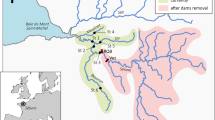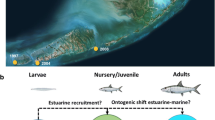Abstract
Otolith microchemistry studies indicate that growth-phase (yellow stage) anguillid eels commonly shift at irregular intervals between fresh and saline waters, but this technique has not detected regular seasonal migrations across salinity zones. We tested the ability of otolith microchemistry and stable isotope analysis to detect migrations of American eels (Anguilla rostrata) between salinity boundaries in two small stream–estuary systems in Canada’s Bay of Fundy. Although the two methods showed concordant classifications of recent residence history, most eels caught in fresh water in spring (68.8–89.7 %) and fall (78.8–83.3 %) showed microchemical and isotopic signatures that reflected occupancy of saline waters. These eels were classified as migrants which had summered in saline waters and then migrated to freshwater wintering grounds where they retained their saline signatures. In summer, most eels (85.0–100.0 %) captured in fresh and saline water had recent microchemical and isotopic signatures matching the habitat of capture. Our results suggest that lifetime otolith microchemistry profiles are unable to detect eel wintering migrations, a failure that is likely due to winter depression of otolith accretion. Elucidation of seasonal eel movements requires cross-seasonal and cross-site sampling for the microchemistry and stable isotope methods, or tagging studies. Seasonal saline–fresh eel migrations may be more common than previously appreciated, underlining the need for conservation of both habitats, and connectivity between the two.




Similar content being viewed by others
References
Arrowsmith P (1987) Laser ablation of solids for elemental analysis by inductively coupled plasma mass spectrometry. Anal Chem 59:1437–1444
Bardonnet A, Riera P (2005) Feeding of glass eels (Anguilla anguilla) in the course of their estuarine migration: new insights from stable isotope analysis. Estuar Coast Shelf Sci 63:201–209
Cairns DK, Shiao JC, Iizuka Y, Tzeng WN, MacPherson CD (2004) Movement patterns of American eels in an impounded watercourse, as indicated by otolith microchemistry. North Am J Fish Manag 24:452–458
Cairns DK, Dutil JD, Proulx S, Mailhiot JD, Bédard MC, Kervella A, Godfrey LG, O’Brien EM, Daley SC, Fournier E, Tomie JPN, Courtenay SC (2012) An atlas and classification of aquatic habitat on the east coast of Canada, with an evaluation of usage by the American eel. Canadian Technical Report of Fisheries and Aquatic Sciences 2986
Campana SE, Thorrold SR (2001) Otoliths, increments, and elements: keys to a comprehensive understanding of fish populations? Can J Fish Aquat Sci 58(30):38
Caron F, Raymond C (1997) Rapport d’opération de la rivière Bec-scie en 1995. Ministère des Ressources naturelles et de la Faune du Québec, Direction de la recherche sur la faune
Charles K, Roussel J-M, Lebel J-M, Bagliniere J-L, Ombredane D (2006) Genetic differentiation between anadromous and freshwater resident brown trout (Salmo trutta L.): insights obtained from stable isotope analysis. Ecol Freshw Fish 15:255–263
Chino N, Arai T (2009) Relative contribution of migratory type on the reproduction of migrating silver eels, Anguilla japonica, collected off Shikoku Island, Japan. Mar Biol 156:661–668
Ciancio JE, Pascual MA, Botto F, Amaya-Santi M, O’Neal S, Riva Rossi C, Iribarne O (2008) Stable isotope profiles of partially migratory salmonid populations in Atlantic rivers of Patagonia. J Fish Biol 72:1708–1719
COSEWIC (2012) COSEWIC assessment and status report of the American eel in Canada. Committee on the Status of Endangered Wildlife in Canada, Ottawa
Cunjak RA, Roussel JM, Gray MA, Dietrich JP, Cartwright DF, Munkittrick KR, Jardine TD (2005) Using stable isotope analysis with telemetry or mark-recapture data to identify fish movement and foraging. Oecologia 144:1–11
Daverat F, Limburg KE, Thibault I, Shiao JC, Dodson JJ, Caron F, Tzeng WN, Iizuka Y, Wickström H (2006) Phenotypic plasticity of habitat use by three temperate eel species Anguilla anguilla, A. japonica, and A. rostrata. Mar Ecol Prog Ser 308:231–241
Dekker W, Casselman J, Cairns DK, Tsukamoto T, Jellyman D, Lickers H (2003) Worldwide decline of eel resources necessitates immediate action: Québec declaration of concern. Fisheries 28:28–30
DeNiro MJ, Epstein S (1978) Influence of diet on the distribution of carbon isotopes in animals. Geochim Cosmochim Ac 42:495–506
DFO (2010) Recovery Strategy for the Atlantic salmon (Salmo salar), inner Bay of Fundy populations [Final]. Species at Risk Act Recovery Strategy Series. Fisheries and Oceans Canada, Ottawa
Doucett RR, Hooper W, Power G (1999) Identification of anadromous and nonanadromous adult brook trout and their progeny in the Tabusintac River, New Brunswick, by means of multiple-stable-isotope analysis. Trans Am Fish Soc 128:278–288
Edeline E (2007) Adaptive phenotypic plasticity of eel diadromy. Mar Ecol Prog Ser 341:229–232
Fletcher GL, Goddard SV, Davies PL, Gong Z, Ewart KV, Hew CL (1998) New insights into fish antifreeze proteins; physiological significance and molecular regulation. In: Portner HO, Playle RC (eds) Cold ocean physiology. Cambridge University Press, Cambridge, pp 239–265
Fry B (1988) Food web structure on Georges Bank from stable C, N, and S isotopic compositions. Limnol Oceanogr 33:1182–1190
Harrod C, Grey J, McCarthy TK, Morrisey M (2005) Stable isotope analyses provide new insights into ecological plasticity in a mixohaline population of European eel. Oecologia 144:673–683
Hesslein RH, Hallard KA, Ramlal P (1993) Replacement of sulfur, carbon, and nitrogen in tissue of growing broad whitefish (Coregonus nasus) in response to a change in diet traced by δ34S, δ13C, and δ15N. Can J Fish Aquat Sci 50:2071–2076
Hobson KA (1999) Tracing the origins and migration of wildlife using stable isotopes: a review. Oecologia 120:314–326
Hobson KA, Clark RW (1992) Assessing avian diets using stable isotopes. I. Turnover of carbon-13. Condor 94:181–188
ICES (2009a) Report of the ICES Study Group on anguillid eels in saline waters (SGAESAW). ICES CM/DFC:06. 183 pp. http://www.ices.dk/reports/SSGEF/2009/SGAESAW09.pdf
ICES (2009b) Workshop on age reading of European and American eel (WKAREA), 20–24 April 2009, Bordeaux, France. ICES CM 2009\ACOM: 48. 66 pp. http://www.ices.dk/reports/ACOM/2009/WKAREA/WKAREA%202009.pdf
Jardine TD, Cunjak RA (2005) Analytical error in stable isotope ecology. Oecologia 144:528–533
Jardine TD, Cartwright DF, Dietrich JP, Cunjak RA (2005) Resource use by salmonids in riverine, lacustrine and marine environments: evidence from stable isotope analysis. Environ Biol Fish 73:309–319
Jessop BM (1987) Migrating American eels in Nova Scotia. Trans Am Fish Soc 116:161–170
Jessop BM, Cairns DK, Thibault I, Tzeng WN (2008a) Life history of American eel Anguilla rostrata: new insights from otolith microchemistry. Aquat Biol 1:205–216
Jessop BM, Shiao JC, Iizuka Y, Tzeng WN (2008b) Prevalence and intensity of occurrence of vaterite inclusions in aragonite otoliths of American eels Anguilla rostrata. Aquat Biol 2:171–178
Jessop BM, Shiao JC, Iizuka Y (2013) Methods for estimating a critical value for determining the freshwater/estuarine habitat residence of American eels from otolith Sr:Ca data. Estuar Coast Shelf S 133:293–303
Keene JL, Noakes DLG, Moccia RD, Soto CG (1998) The efficacy of clove oil as an anaesthetic for rainbow trout, Oncorhynchus mykiss (Walbaum). Aquac Res 29:89–101
Kraus RT, Secor DH (2004) Incorporation of strontium into otoliths of an estuarine fish. J Exper Mar Biol Ecol 302:85–106
Lamson HM, Shiao JC, Iizuka Y, Tzeng WN, Cairns DK (2006) Movement patterns of American eels (Anguilla rostrata) between salt and freshwater in a coastal watershed, based on otolith microchemistry. Mar Biol 149:1567–1576
Marohn L, Prigge E, Zumholz K, Klügel A, Anders H, Hanel R (2009) Dietary effects on multi element composition of European eel (Anguilla anguilla) otoliths. Mar Biol 156:927–933
Marohn L, Hilge V, Zumholz K, Klugel A, Anders H, Hanel R (2011) Temperature dependency of element incorporation into European eel (Anguilla anguilla) otoliths. Anal Bioanal Chem 399:2175–2184
Medcof JC (1969) Fishermen’s reports of freshwater and saltwater migrations of Nova Scotia eels (Anguilla rostrata). Can Field Nat 83:132–138
Merritt RW, Cummins KW (1996) An introduction to the aquatic insects of North America, 3rd edn. Kendall/Hunt, Dubuque
Miller JA (2011) Effects of water temperature and barium concentration on otolith composition along a salinity gradient: implications for migratory reconstructions. J Exp Mar Biol Ecol 405:42–52
Minagawa M, Wada E (1984) Stepwise enrichment of 15N along food chains: further evidence and the relation between 15N and animal age. Geochim Cosmochim Acta 48:1135–1140
Peterson BJ, Fry B (1987) Stable isotopes in ecosystem studies. Annu Rev Ecol Syst 18:293–320
Renaud JM, Moon TW (1980) Starvation and the metabolism of hepatocytes isolated from the American eel, Anguilla rostrata LeSueur. J Comp Physiol 135:127–137
Sadovy Y, Severin KP (1992) Trace elements in biogenic aragonite: correlation of body growth rate and strontium levels in the otoliths of the white grunt, Haemulon plumieri (Pisces: Haemulidae). Bull Mar Sci 50:237–257
Sanborn M, Telmer K (2003) The spatial resolution of LA–ICP–MS line scans across heterogeneous materials such as fish otoliths and zoned minerals. J Anal At Spectrom 18:1231–1237
Smith MW, Saunders JW (1955) The American eel in certain fresh waters of the Maritime Provinces of Canada. J Fish Res Bd Can 12:238–269
Surber EW (1936) Rainbow trout and bottom fauna production in one mile of stream. Trans Am Fish Soc 66:193–202
Suzuki KW, Akihide K, Kouji N, Masaru T (2005) Differential isotopic enrichment and half-life among tissues in Japanese temperate bass (Lateolabrax japonicus) juveniles: implications for analyzing migration. Can J Fish Aquat Sci 62:671–678
Thibault I, Dodson JJ, Caron F (2007a) Yellow stage American eel movements determined by microtagging and acoustic telemetry in the St. Jean River watershed, Gaspé (Quebec, Canada). J Fish Biol 71:1095–1112
Thibault I, Dodson JJ, Caron F, Tzeng WN, Iizuka Y, Shiao JC (2007b) Facultative catadromy in the American eel: testing the conditional strategy hypothesis. Mar Ecol Prog Ser 344:219–229
Tieszen LL, Boutton TW, Tesdahl KG, Slade NA, (1983) Fractionation and turnover of stable carbon isotopes in animal tissues: implications for d13C analysis of diet. Oecologia 57:32–37
Tomie JPN (2011) The ecology and behaviour of substrate occupancy by the American eel. MSc thesis, University of New Brunswick, Fredericton
Veinott GI, Porter TR, Nasdala L (2009) Using Mg as a proxy for crystal structure and Sr and an indicator of marine growth in vaterite and aragonite otoliths of aquaculture rainbow trout. Trans Am Fish Soc 138:1157–1165
Verreault G (2002) Dynamique de la sous-population d’anguilles d’Amérique (Anguilla rostrata) du basin versant de la rivière du Sud-ouest. MSc thesis, Université du Québec à Rimouski
Watling L (1975) Analysis of structural variations in a shallow estuarine deposit-feeding community. J Exp Mar Biol Ecol 19:275–313
Webb SD, Woodcock SH, Gillanders BM (2012) Sources of otolith barium and strontium in estuarine fish and the influence of salinity and temperature. Mar Ecol Prog Ser 453:189–199
Acknowledgments
We thank Peter Hardie of the Department of Fisheries and Oceans (Moncton, NB) and summer assistants (Sylvie Robichaud, Wally Roach and Stéphan Leblanc) for technical support in the field. The Fort Folly First Nation Habitat Recovery Team and Fundy National Park of Canada also provided appreciated assistance in the field. This study was funded through Fundy National Park’s contract number FNP05-032 and DFO Science funds.
Author information
Authors and Affiliations
Corresponding author
Additional information
Communicated by Steve Swearer.
Rights and permissions
About this article
Cite this article
Clément, M., Chiasson, A.G., Veinott, G. et al. What otolith microchemistry and stable isotope analysis reveal and conceal about anguillid eel movements across salinity boundaries. Oecologia 175, 1143–1153 (2014). https://doi.org/10.1007/s00442-014-2969-8
Received:
Accepted:
Published:
Issue Date:
DOI: https://doi.org/10.1007/s00442-014-2969-8




